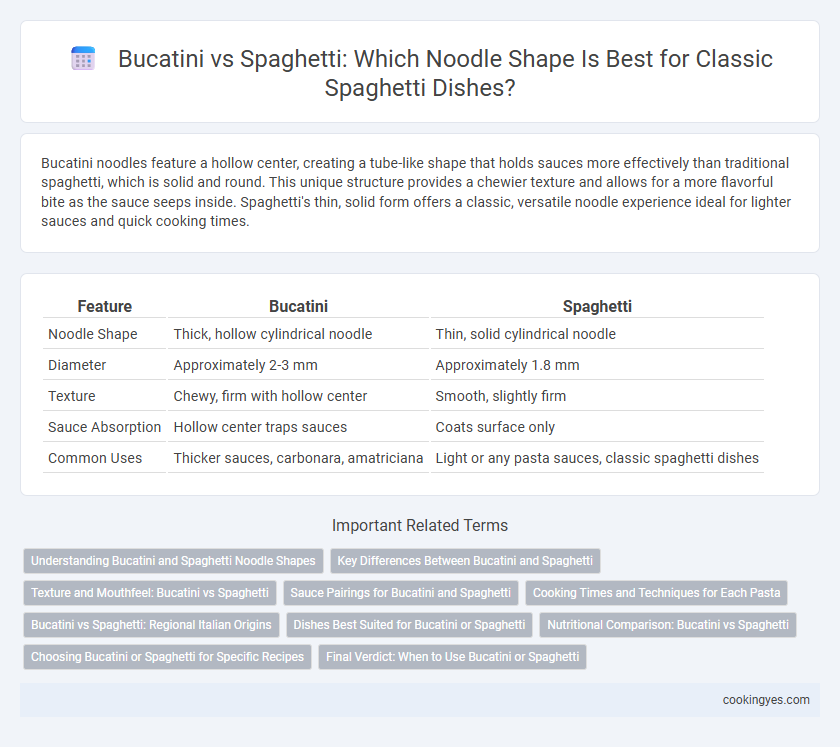Bucatini noodles feature a hollow center, creating a tube-like shape that holds sauces more effectively than traditional spaghetti, which is solid and round. This unique structure provides a chewier texture and allows for a more flavorful bite as the sauce seeps inside. Spaghetti's thin, solid form offers a classic, versatile noodle experience ideal for lighter sauces and quick cooking times.
Table of Comparison
| Feature | Bucatini | Spaghetti |
|---|---|---|
| Noodle Shape | Thick, hollow cylindrical noodle | Thin, solid cylindrical noodle |
| Diameter | Approximately 2-3 mm | Approximately 1.8 mm |
| Texture | Chewy, firm with hollow center | Smooth, slightly firm |
| Sauce Absorption | Hollow center traps sauces | Coats surface only |
| Common Uses | Thicker sauces, carbonara, amatriciana | Light or any pasta sauces, classic spaghetti dishes |
Understanding Bucatini and Spaghetti Noodle Shapes
Bucatini noodles feature a unique hollow center, allowing sauce to fill the tube, enhancing flavor in every bite, while spaghetti noodles are solid and cylindrical, offering a consistent texture throughout. The hollow design of bucatini makes it ideal for capturing thicker, richer sauces, contrasting with spaghetti's versatility for lighter and smoother sauces. Choosing between bucatini and spaghetti depends on the desired sauce pairing and texture experience.
Key Differences Between Bucatini and Spaghetti
Bucatini features a hollow center, offering a unique texture and ability to hold sauces inside the noodle, while spaghetti is solid and smooth throughout, providing a consistent bite. The thickness of bucatini is generally slightly thicker than spaghetti, which affects cooking time and sauce absorption. These differences influence dish choices, with bucatini often preferred for thicker, hearty sauces and spaghetti favored for lighter, oil-based or creamy sauces.
Texture and Mouthfeel: Bucatini vs Spaghetti
Bucatini's hollow center provides a unique, chewy texture that contrasts with traditional spaghetti's smooth, firm bite. This hollow shape allows sauces to coat and seep inside the noodle, enhancing flavor delivery with each mouthful. Spaghetti offers a classic, consistent mouthfeel ideal for lighter, oil-based or tomato sauces, while bucatini excels in richer, thicker sauces due to its textural complexity.
Sauce Pairings for Bucatini and Spaghetti
Bucatini's hollow, thick strands excel at holding rich, chunky sauces like amatriciana and carbonara, allowing flavors to infuse inside the noodle for a burst of taste with every bite. Traditional spaghetti, thinner and solid, pairs best with lighter, smooth sauces such as marinara or aglio e olio, coating the noodles evenly without overpowering their delicate texture. Sauce viscosity and noodle shape balance is key: bucatini's tube structure supports heavier, meat-based sauces, while spaghetti complements finer, oil-based or tomato sauces.
Cooking Times and Techniques for Each Pasta
Bucatini, thicker and hollow, requires longer cooking times than traditional spaghetti, typically around 9-12 minutes versus spaghetti's 7-10 minutes. The hollow center of bucatini allows sauce to cling inside, enhancing flavor absorption, while spaghetti's solid shape suits lighter, oil-based sauces. Precise timing and frequent stirring are essential for bucatini to avoid clumping, whereas spaghetti cooks evenly with gentle stirring to prevent sticking.
Bucatini vs Spaghetti: Regional Italian Origins
Bucatini, originating from Lazio and famously from Rome, is a thick, hollow pasta that offers a unique texture compared to traditional spaghetti, which is a solid, thin noodle common throughout Italy. The hollow center of Bucatini allows it to hold sauces like amatriciana more effectively, enhancing flavor absorption. Spaghetti's widespread presence across Italian regions reflects its versatility, while Bucatini remains emblematic of central Italian culinary traditions.
Dishes Best Suited for Bucatini or Spaghetti
Bucatini features a hollow center that allows it to hold rich, thick sauces like Amatriciana or carbonara, making it ideal for hearty, sauce-heavy dishes. Spaghetti, with its solid, thin strands, pairs best with lighter sauces such as aglio e olio or simple tomato-based sauces. Choosing between bucatini and spaghetti depends on the sauce's consistency and the desired texture in the dish.
Nutritional Comparison: Bucatini vs Spaghetti
Bucatini and spaghetti differ primarily in shape, with bucatini featuring a hollow center that slightly affects texture rather than significant nutritional variations. Both noodles offer comparable calories, carbohydrates, and protein per serving, with minimal differences in fiber and fat content. The hollow channel in bucatini does not substantially alter its macronutrient profile compared to the solid structure of spaghetti.
Choosing Bucatini or Spaghetti for Specific Recipes
Bucatini features a hollow center that allows sauces to cling inside, making it ideal for rich, thick sauces like Amatriciana or carbonara, while traditional spaghetti's solid, thin strands work better with lighter, oil-based or tomato sauces. The choice between bucatini and spaghetti depends on the sauce consistency and desired texture in dishes such as cacio e pepe or marinara. For recipes requiring a robust noodle that captures flavor internally, bucatini is preferred, whereas spaghetti suits delicate, smooth sauces.
Final Verdict: When to Use Bucatini or Spaghetti
Bucatini, with its hollow center, is ideal for thick, rich sauces like amatriciana or carbonara, as the tube shape traps sauce for enhanced flavor in every bite. Spaghetti, thinner and solid, pairs well with lighter, smoother sauces such as marinara or aglio e olio, providing a delicate balance without overpowering the pasta. Choose bucatini for hearty, sauce-heavy dishes requiring texture contrast, and spaghetti for simple, elegant meals emphasizing sauce subtlety and classic presentation.
Bucatini vs spaghetti for noodle shape Infographic

 cookingyes.com
cookingyes.com